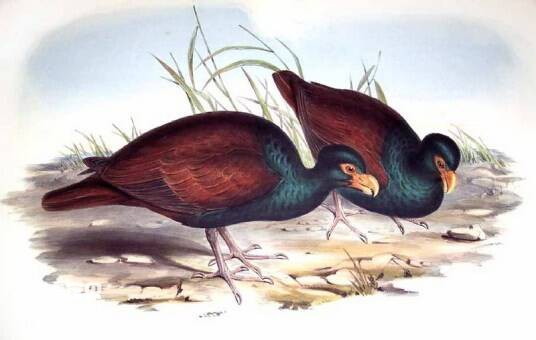Didunculus strigirostris
IUCN
LCBasic Information
Scientific classification
- name:Didunculus strigirostris
- Scientific Name:Didunculus strigirostris,Tooth-billed Pigeon
- Outline:Landfowl
- Family:
Vital signs
- length:32-35CM
- Weight:About 400g
- lifetime:No textual research information is available
Feature
The mandible is named for having two "teeth"
Distribution and Habitat
It is found on only three small birds in western Samoa, Savai 'i, Upolu and Nuuterei.
This unusual pigeon shows a strong preference for living in virgin forest without any disturbance. They dwell on a blue blue tree (Dysoxylum excelsum, a blue blue tree in the neem family), and their seeds may be their only source of food.
Appearance
The tooth beak dove is 32 ~ 35 cm long and weighs 400 grams. The beak is large and firm, the upper beak strongly curved like a hook; The mandibular region is protruding, with three cone-shaped indentations on either side. The skin is red in front of the eye and around the small eye area. The forehead and neck have a light blue or blue-green gloss, and the overall plumage is very beautiful in silver black. Lustrous brown on lower parts and wings; The large overlying plumage is grayish brown; Primary and secondary flying chestnut color; The back and tail coverts are dark brown. The tail darkens and takes on a reddish maroon color. The throat, neck, chest and ear feathers are black, and their gray shadows are reflected in dark green. The abdomen has a slight blackish-green luster; The sides, thighs and anus are grayish-brown. His feet are naked. Iris dark brown; Beak yellow or orange, base red waxy; Dark red legs.
Male and female alike, the juvenile has no green luster on the head, nec
Details
Didunculus strigirostris Tooth-billed Pigeon, no subspecies.

Doves live at altitudes ranging from 300 to 1400 meters above sea level and are sexually shy and difficult to approach. The singing sound is similar to that of ordinary domestic pigeons, often making a "gu-gu-gu" sound. It is a social bird that gathers in small groups of 20 or 30 birds. Due to environmental damage, the population is endangered, and only smaller groups or pairs or even single toothed doves are seen. It is a very cautious pigeon that lives almost entirely arboreal and spends most of its time hiding in the leaves of tall trees. If it takes off, its wings will generate great power, and the flight will be agile and fast. It will stand at a certain height and make a chirping sound, slightly lowering its head, as if it is tutting and praising the call.
Much of the breeding habits of the toothed dove are unknown. It was once called nesting on the ground. In fact, for fear of predators, toothed doves nest in trees, which can be up to 15 meters above the ground. Usually two eggs are laid in each clutch, and both parents hatch together, taking turns in the nest on a very regular basis. The duration of the hatching period and good nest is unknown.
In the mid-1980s, the number of toothed doves was between 4,800 and 7,200. After the hurricanes of the early '90s, the population has dropped to about 2,500. Increasing agricultural land area and deforestation are the biggest dangers facing the species, and hunting is also increasing the pressure on the species to become endangered. By 1985, nearly 400 birds were being killed each year. Fortunately, the species has been protected in time and is not allowed to be photographed or disturbed by humans. Also, in Samoa, the bird was chosen as the emblem of the organization Developing the Conservation of Natural Heritage.
Listed on the International Union for Conservation of Nature (IUCN) 2012 Red List of Threatened Species ver 3.1 - Endangered (EN).
Protect wild animals and eliminate wild meat.
Maintaining ecological balance is everyone's responsibility!








